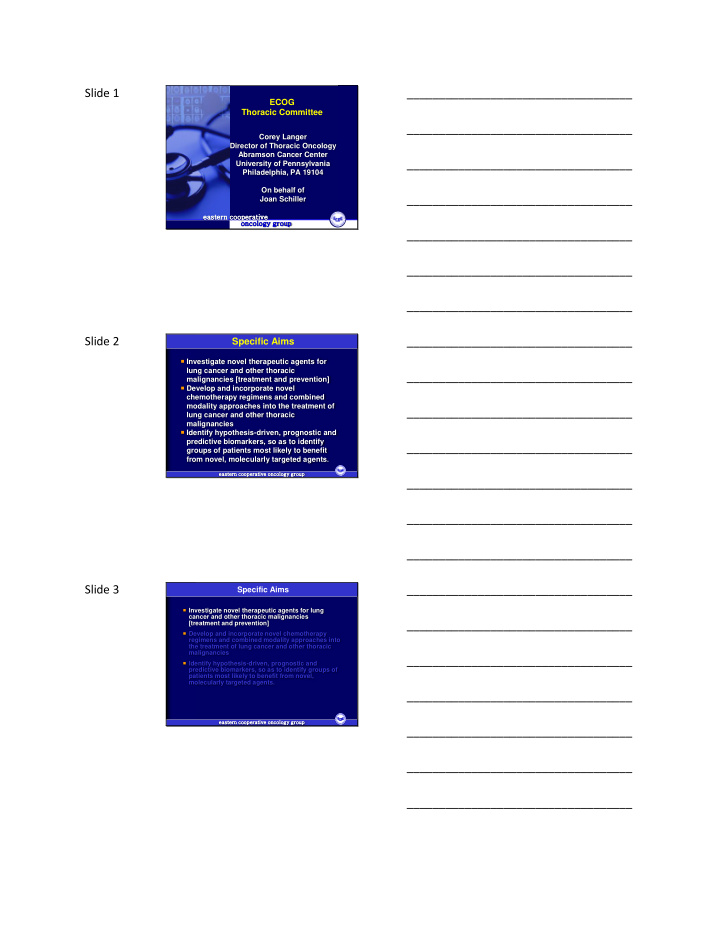



Slide 1 ___________________________________ ECOG Thoracic Committee ___________________________________ Corey Langer Director of Thoracic Oncology Abramson Cancer Center ___________________________________ University of Pennsylvania Philadelphia, PA 19104 On behalf of ___________________________________ Joan Schiller ea easte stern coope ooperativ ive oncol on ology gr group oup ___________________________________ ___________________________________ ___________________________________ Slide 2 ___________________________________ Specific Aims Investigate novel therapeutic agents for lung cancer and other thoracic ___________________________________ malignancies [treatment and prevention] Develop and incorporate novel chemotherapy regimens and combined modality approaches into the treatment of ___________________________________ lung cancer and other thoracic malignancies Identify hypothesis-driven, prognostic and predictive biomarkers, so as to identify ___________________________________ groups of patients most likely to benefit from novel, molecularly targeted agents . eas astern coop cooperativ ive oncol oncolog ogy gr group oup ___________________________________ ___________________________________ ___________________________________ Slide 3 ___________________________________ Specific Aims Investigate novel therapeutic agents for lung cancer and other thoracic malignancies ___________________________________ [treatment and prevention] Develop and incorporate novel chemotherapy regimens and combined modality approaches into the treatment of lung cancer and other thoracic malignancies ___________________________________ Identify hypothesis-driven, prognostic and predictive biomarkers, so as to identify groups of patients most likely to benefit from novel, molecularly targeted agents. ___________________________________ eas astern coop cooperativ ive oncol oncolog ogy gr group oup ___________________________________ ___________________________________ ___________________________________
Slide 4 ___________________________________ Specific Aims Investigate novel therapeutic agents for lung cancer and other thoracic malignancies ___________________________________ Selenium: Trace Mineral as Chemoprevention Angiogenesis • Hypothesis: anti-angiogenic drugs have activity in lung cancer, and can improve the outcome of ___________________________________ patients, either as single agents, or in combination with chemotherapy ___________________________________ eas astern coop cooperativ ive oncol oncolog ogy gr group oup ___________________________________ ___________________________________ ___________________________________ Slide 5 ___________________________________ Stage I NSCLC: Chemoprevention E-91025: phase III randomized, placebo-controlled evaluation of cRA in pathologically proven T 1 N 0 , T 2 N 0 ___________________________________ NSCLC; accrual (n=1482) completed ~ 4/97; no benefit (except in never smokers)… Lippman SM, Journal of the National Cancer Institute, Vol. 93, No. 8, 605-618, April 18, 2001 E5597: Placebo controlled trial evaluating selenium in ___________________________________ stage I disease (featured at ASCO ‘10) ___________________________________ eas astern coop cooperativ ive oncol oncolog ogy gr group oup ___________________________________ ___________________________________ ___________________________________ Slide 6 ___________________________________ E5597: Phase III Chemoprevention Trial of Selenium Supplementation in Persons with Resected Stage I Non-Small Cell Lung Cancer ___________________________________ Daniel D. Karp, Sandra Lee, Gail Shaw Wright, David Johnson, Michael Johnston, Gary Goodman, Gerald Clayman, Gordon Okawara, Randolph Marks, Jack Ruckdeschel Eastern Cooperative Oncology Group ___________________________________ Together with Cancer and Acute Leukemia Group B NCI Canada Treatment Group North Central Cancer Treatment Group Radiation Therapy Oncology Group Southwest Oncology Group ___________________________________ Enrollment from Oct. 2000 – Nov. 2009 ASCO 2010 eas astern coop cooperativ ive oncol oncolog ogy gr group oup ___________________________________ ___________________________________ ___________________________________
Slide 7 ___________________________________ Selenium Intergroup Prevention Study in Resected Stage I NSCLC Objectives ___________________________________ Reduce incidence of second primary tumors (SPTs) Evaluate safety and toxicity of L-Seleno-methionine Compare overall and organ specific cancer mortality • Selenium 200 microgms/day for ELIGIBILITY** 48 months ___________________________________ 1. Stage pT1N0 and pT2N0 • Monitor for safety, SPTs and 2. 6 – 36mo. post-op recurrence 3. Adjuvant Chemo allowed^ 4. Normal organ function 5. ECOG PS 0 or 1 • Placebo daily for 48 months Compliance with 4 wk “run - in” 6. • Monitor for safety, SPTs, and 7. No dietary supplements ___________________________________ recurrence 8. No synchronous cancers **Stratify by smoking status and gender ^ Based on subsequent amendment eas astern coop cooperativ ive oncol oncolog ogy gr group oup ___________________________________ ___________________________________ ___________________________________ Slide 8 ___________________________________ Stratification s 1. Smoking Status ___________________________________ Active (within 1 yr) Former (> 1 year) Never smoked (< 100 cigarettes) 2. Gender Male ___________________________________ Female 3. Stage /Previous Therapy Ia Ib no chemotherapy ___________________________________ Ib prior chemotherapy eas astern coop cooperativ ive oncol oncolog ogy gr group oup ___________________________________ ___________________________________ ___________________________________ Slide 9 ___________________________________ Selenium and Lung Cancer: A Quantitative Analysis of the Current Epidemiological Literature Hanjing Zhuo, Allan H. Smith, and Craig Steinmaus. Cancer Epidemiology, Biomarkers & Prevention 2004; 13(5). May 2004 Clark et al: 30% reduction in prostate and lung cancer with ___________________________________ Se enrichment Meta-analysis of 16 studies 5 as Relative Risk (RR) ___________________________________ 3 as Mean Differences (MD) 8 both RR & MD Overall pooled RR is 0.74 (95% CI 0.57-0.97) c2 = 28.9 p<0.01) ___________________________________ Protective effects greater in low Se areas Hypothesis: Threshold effect eas astern coop cooperativ ive oncol oncolog ogy gr group oup ___________________________________ ___________________________________ ___________________________________
Slide 10 ___________________________________ Selenium: Proposed MOAs ___________________________________ Stimulation of glutathione peroxidase thereby lowering tissue peroxides. Alterations in carcinogen metabolism. ___________________________________ Production of cytotoxic selenium metabolites. Inhibition of protein synthesis. Inhibition of specific enzymes. Stimulation of apoptosis. ___________________________________ eas astern coop cooperativ ive oncol oncolog ogy gr group oup ___________________________________ ___________________________________ ___________________________________ Slide 11 ___________________________________ Objects of E5597 Evaluate the efficacy of Selenium in ___________________________________ Preventing second primary cancers in patients who have had a curative resection for Stage I NSCLC Assess Toxicity Lab Correlates Steve Belinsky, Lovelace Institute, Albuquerque, NM ___________________________________ Determine prevalence of • methylation of p16 • O6-methylguanine-DNA methyltransferase (MGMT) Longitundinal determination of methylation profile. Assessment of DNA Oxidation Products ___________________________________ • 5- Hydroxymethyldeoxyuridine (5-HETE) • Lipoxygenase (LTB4) eas astern coop cooperativ ive oncol oncolog ogy gr group oup ___________________________________ ___________________________________ ___________________________________ Slide 12 ___________________________________ Selenium Intergroup Prevention Study in Resected Stage I NSCLC Objectives ___________________________________ Reduce incidence of second primary tumors (SPTs) Evaluate safety and toxicity of L-Seleno-methionine Compare overall and organ specific cancer mortality ___________________________________ • Selenium 200 microgms/day for ELIGIBILITY** 48 months 1. Stage pT1N0 and pT2N0 • Monitor for safety, SPTs and 2. 6 – 36mo. post-op recurrence 3. Adjuvant Chemo allowed 4. Normal organ function 5. ECOG PS => 0 or 1 • Placebo daily for 48 months ___________________________________ Compliance with “run - in” 6. • Monitor for safety, SPTs, and 7. No dietary supplements recurrence 8. No synchronous cancers **Stratify by smoking status and gender eas astern coop cooperativ ive oncol oncolog ogy gr group oup ___________________________________ ___________________________________ ___________________________________
Recommend
More recommend